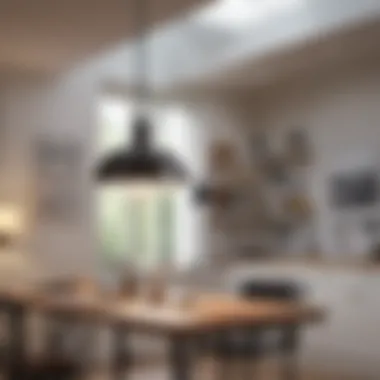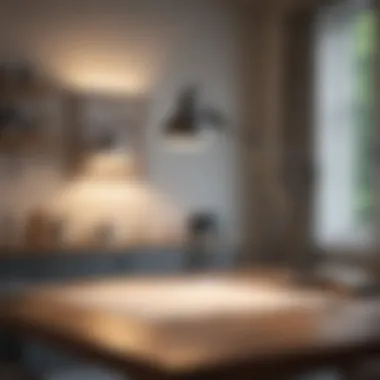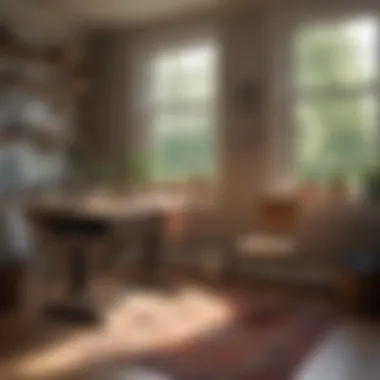Illuminate Your Sewing Room: A Comprehensive Guide to Choosing the Perfect Lighting Setup


Interior Design Tips
When embarking on the journey to illuminate your sewing room, it is crucial to consider various aspects of interior design. Proper lighting not only enhances the functionality of your workspace but also contributes significantly to the overall aesthetic appeal. Understanding trendy design ideas and experimenting with different color schemes and combinations can elevate your sewing room's ambiance. Additionally, mastering furniture arrangement techniques will help you optimize both lighting distribution and workflow efficiency.
Lighting Fundamentals
Before delving into specific lighting fixtures, it is essential to grasp the foundational principles of lighting design. The intensity, color temperature, and direction of light all play pivotal roles in creating an ideal sewing environment. Prioritize illuminating your primary workspace with bright, focused lighting to enhance visual clarity and reduce eye strain. Simultaneously, explore ways to incorporate ambient lighting for a cozy and inviting feel.
Types of Lighting Fixtures
There exists a multitude of lighting options tailor-made for sewing rooms, each offering unique benefits and functionalities. From overhead fixtures such as pendant lights and track lighting to task-specific lamps like floor lamps and adjustable desk lamps, the key lies in achieving a harmonious blend of different light sources. Opt for fixtures that enable flexibility and versatility, allowing you to adapt the lighting according to specific tasks and preferences.
Task Lighting Solutions
Task lighting serves as the cornerstone of effective sewing room illumination. Consider installing adjustable LED lights directly above your sewing machine to illuminate the work surface adequately. Alternatively, clip-on task lights offer portability and targeted lighting, ideal for intricate stitching or detailed work. By strategically incorporating various task lighting options, you can create a dynamic lighting setup tailored to your specific sewing needs.
Illumination Optimization
Achieving optimal lighting in your sewing room involves a meticulous balance of different lighting elements. While natural light provides a refreshing ambiance during the day, supplementing it with artificial lighting sources enhances consistency and prevents fluctuations in brightness. Experiment with different lighting combinations and placements to eliminate shadows, minimize glare, and create a harmonious environment conducive to focused sewing sessions.
Remember, the key to a well-lit sewing room lies in versatility and adaptability. Incorporate a mix of overhead, task, and ambient lighting to create a dynamic lighting ecosystem that caters to all your sewing requirements.
Preamble to Sewing Room Lighting
Sewing room lighting forms a crucial aspect of creating an optimal workspace for your craft. Understanding the impact of lighting on your sewing precision can significantly enhance your efficiency and overall experience. Factors such as color temperature, brightness levels, flexibility, and adjustability are vital considerations when choosing the right lighting setup for your sewing room. Avoiding common lighting mistakes such as overhead lighting pitfalls, ignoring task lighting, and using harsh or dim lighting is essential to ensure your workspace is conducive to creativity and productivity.
Understanding the Significance of Sewing Room Lighting
The impact of lighting on sewing precision
Lighting plays a pivotal role in determining the accuracy of your stitches and the quality of your sewing projects. Proper lighting not only illuminates your workspace but also accentuates details, making it easier to work on intricate designs. By optimizing lighting conditions, you can significantly improve the precision and overall outcome of your sewing endeavors. Choosing the right lighting setup that ensures consistent brightness and illumination across your workspace is key to achieving impeccable results.
Enhancing focus and reducing eye strain
Efficient lighting not only enhances your focus on the task at hand but also plays a critical role in reducing eye strain. Adequate lighting levels help prevent eye fatigue, enabling you to work for extended periods comfortably. By selecting lighting fixtures that provide uniform brightness and are positioned ergonomically, you can create a conducive environment for sustained focus and stamina during your sewing sessions.


Factors to Consider When Choosing Lighting
Natural light vs. artificial light
The choice between natural and artificial light sources can significantly impact the ambiance and functionality of your sewing room. Natural light has a unique quality that artificial light cannot replicate, offering a sense of warmth and connection to the outdoors. However, artificial lighting provides consistency and control, allowing you to work at any time of the day without being dependent on external lighting conditions.
Color temperature and brightness levels
Color temperature and brightness levels are essential considerations when selecting lighting for your sewing space. The color temperature of light influences the mood and clarity of your workspace, with cooler temperatures promoting focus and productivity, whereas warmer tones create a cozy and inviting atmosphere. Balancing brightness levels ensures adequate illumination without causing glare or shadows, ensuring optimal visibility and comfort while sewing.
Flexibility and adjustability
Opting for lighting fixtures that offer flexibility and adjustability allows you to customize your lighting according to specific tasks and preferences. Adjustable desk lamps, floor lamps with flexible necks, and dimmable overhead fixtures enable you to tailor the lighting to suit varying needs throughout your sewing process. Flexibility in lighting design ensures adaptability to changing lighting requirements and enhances the versatility of your sewing room setup.
Common Lighting Mistakes to Avoid
Overhead lighting pitfalls
Overreliance on overhead lighting can lead to uneven illumination and shadows, impacting the clarity and precision of your work. Positioning lights directly above your workstation may create harsh shadows and hinder visibility, especially when working on intricate details. Supplementing overhead lighting with additional task lighting sources can help mitigate these drawbacks and ensure uniform lighting distribution across your sewing area.
Ignoring task lighting
Neglecting the importance of task lighting, which targets specific work areas, can result in inadequate illumination and eye strain. Task lighting, such as adjustable desk lamps or focused floor lamps, plays a critical role in providing directed light where needed, enhancing visibility and minimizing shadows. Incorporating task lighting into your overall lighting scheme enhances the functionality and efficiency of your sewing room, allowing you to work with precision and ease.
Using harsh or dim lighting
Extreme lighting conditions, such as harsh brightness or dimness, can impede your sewing experience and strain your eyes. Harsh lighting may create glare and discomfort, while dim lighting can lead to squinting and difficulty in distinguishing details. Optimal lighting levels that strike a balance between brightness and softness are essential to creating a well-lit and comfortable sewing environment, promoting productivity and enjoyment in your craft.
Types of Lighting Fixtures for Sewing Rooms
In this comprehensive guide to choosing the perfect lighting setup for your sewing room, the section on Types of Lighting Fixtures holds significance. Understanding the importance of selecting the right lighting fixtures can drastically influence your sewing experience. Natural Lighting Options allow for a blend of functionality and aesthetics, while Recommended Artificial Lighting offers customizable solutions for your workspace. Finally, Innovative Lighting Solutions present modern and efficient alternatives to traditional lighting fixtures. Each of these categories plays a vital role in optimizing your sewing room's illumination setup.
Natural Lighting Options
Positioning workstations near windows:


Positioning your workstation near windows can significantly impact the overall lighting quality in your sewing room. By harnessing natural light, you benefit from enhanced brightness and a more vibrant working environment. Moreover, natural light contributes to reducing energy consumption and creating a healthier ambiance for your projects. This approach aligns with the goal of creating a well-lit and inspiring workspace, making it a popular choice among sewing enthusiasts seeking optimal lighting conditions.
Using sheer curtains or blinds for light control:
Integrating sheer curtains or blinds offers a practical solution for controlling the natural light entering your sewing room. These accessories allow you to adjust the amount of light based on your specific needs, preventing glare on your projects and ensuring a comfortable working environment. While providing flexibility in illumination, sheer curtains or blinds also add a touch of elegance to your sewing space, further enhancing its visual appeal.
Recommended Artificial Lighting
Task lighting with adjustable desk lamps:
Task lighting provided by adjustable desk lamps is a versatile and essential component of any sewing room lighting setup. These lamps offer focused illumination for detailed craftsmanship, ensuring precision in your work. The adjustability feature allows you to customize the angle and intensity of light, catering to different sewing tasks and preferences. Despite their compact size, task lighting with adjustable desk lamps plays a significant role in enhancing your overall sewing experience, making them a popular choice among sewing enthusiasts.
Floor lamps with flexible necks for focused illumination:
Floor lamps with flexible necks provide targeted lighting that can be easily adjusted to meet varying lighting requirements. The flexible design enables you to direct light precisely where needed, illuminating your projects with high accuracy. This focused illumination enhances visibility and concentration during intricate sewing tasks, contributing to improved productivity and work quality. The adaptability of floor lamps with flexible necks makes them a practical and efficient choice for enhancing your sewing room's lighting setup.
Overhead lighting fixtures like pendant lights or track lighting:
Overhead lighting fixtures such as pendant lights or track lighting offer general illumination that complements task-oriented lighting sources. These fixtures provide ambient light to brighten the overall space, creating a balanced lighting environment. Pendant lights or track lighting add a decorative element to your sewing room while ensuring adequate brightness for various sewing activities. While optimizing the overall lighting scheme, these fixtures help in achieving a harmonious and well-lit sewing space.
Innovative Lighting Solutions for Sewing Rooms
LED strip lights for under-cabinet or shelf lighting:
LED strip lights present a modern solution for illuminating specific areas within your sewing room, such as under cabinets or shelves. These lights offer a sleek and energy-efficient way to enhance visibility in confined spaces, showcasing your workstations effectively. Additionally, the versatility of LED strip lights allows for creative lighting arrangements, elevating the aesthetic appeal of your sewing room while providing practical lighting benefits. Despite their innovative features, it is essential to consider the installation and power efficiency aspects when incorporating LED strip lights in your sewing room.
Swing arm wall sconces for versatile lighting options:
Swing arm wall sconces introduce a dynamic and adaptable lighting solution to sewing rooms, offering flexibility in lighting angles and coverage. These fixtures allow you to direct light as needed, accommodating different sewing tasks and preferences. The versatility of swing arm wall sconces enables you to create personalized lighting settings that enhance your sewing experience. While being functional, these fixtures add a stylish element to your sewing room decor, merging practicality with aesthetic appeal for a well-rounded lighting solution.
Optimizing Your Sewing Room Lighting Setup
In the realm of sewing room design, the pivotal element that often receives inadequate attention is lighting. Optimizing your sewing room lighting setup can truly make a monumental difference in the functionality and aesthetics of your workspace. By focusing on specific elements such as ambient, task, and accent lighting, you can elevate your sewing experience to new heights.
Creating Layered Lighting


Ambient, Task, and Accent Lighting for Functionality
The concept of layered lighting, incorporating ambient, task, and accent lighting, is not merely a design trend but a fundamental principle in creating an effective sewing room setup. Ambient lighting provides overall illumination, task lighting targets specific work areas, and accent lighting adds depth and visual interest. Implementing this trifecta of lighting options ensures a well-lit space conducive to creativity and precision. Furthermore, the layered approach contributes to a dynamic and versatile environment, catering to various sewing tasks.
Balancing Overall Illumination for a Well-Lit Space
Achieving the right balance of illumination is essential in preventing eye strain and promoting productivity. Balancing overall illumination ensures that no corner of your sewing room is left in shadow, guaranteeing a uniformly well-lit space. By harmonizing different lighting sources, you create a comfortable and visually stimulating atmosphere, essential for long sewing sessions. This equilibrium between light and shadow is not only aesthetically pleasing but also functional, enhancing your sewing capabilities.
Avoiding Glare and Shadows
Positioning Lights to Prevent Glare on Sewing Projects
One of the most common challenges in sewing rooms is dealing with glare, which can be detrimental to focus and precision. Properly positioning lights to prevent glare on sewing projects is paramount. By angling light sources strategically and incorporating glare-reducing features such as frosted bulbs or shades, you can minimize glare without compromising brightness. This careful positioning not only protects your eyes but also ensures optimal conditions for detailed work.
Eliminating Dark Spots with Strategic Lighting Placements
Dark spots can impede your sewing progress, leading to errors and inconsistencies in your projects. Eliminating dark spots through strategic lighting placements involves identifying and illuminating areas that tend to be overlooked. By strategically placing lighting fixtures such as adjustable desk lamps or track lighting, you can eliminate shadows and maintain a uniformly lit environment. This proactive approach guarantees that every stitch receives the attention it deserves.
Personalizing Your Lighting Scheme
Adding Dimmers for Adjustable Brightness
Introducing dimmers into your lighting scheme offers the flexibility to adjust brightness levels according to your specific needs at any given moment. Dimmers not only allow you to create different moods within your sewing room but also save energy by reducing light intensity when full brightness is unnecessary. This customization element adds a layer of convenience, enabling you to tailor your lighting to match your current sewing tasks.
Incorporating Decorative Lighting Elements
Beyond mere functionality, decorative lighting elements bring a touch of personality and style to your sewing room. From elegant pendant lights to whimsical wall sconces, incorporating decorative lighting allows you to infuse your space with character and charm. These elements not only illuminate your room but also serve as design features, enhancing the aesthetic appeal of your sewing sanctuary.
The End
In this comprehensive guide to choosing the perfect lighting setup for your sewing room, it becomes clear that proper illumination is not just about brightness but about creating an environment that fosters creativity, efficiency, and precision. By understanding the significance of sewing room lighting and considering various factors like natural light vs. artificial light, color temperature, and adjustability, you can elevate your sewing experience to new heights.
Elevate Your Sewing Experience with Proper Lighting
Enhancing efficiency and precision in your sewing projects
When it comes to enhancing efficiency and precision in your sewing projects, having the right lighting plays a crucial role. The ability to see details clearly, stitch accurately, and work without straining your eyes is paramount. Optimal lighting can make the difference between a mediocre stitching job and a masterpiece. By illuminating your workspace with focused, adjustable task lighting, you can achieve a level of finesse and accuracy that was previously unattainable. This level of precision not only saves time but also ensures that your finished products are of the highest quality.
Transforming your sewing room into an inspiring workspace
Transforming your sewing room into an inspiring workspace involves creating an environment that motivates and energizes your creative process. By strategically incorporating lighting elements that boost mood and ambiance, you can turn your sewing room into a sanctuary of inspiration. Imagine soft, warm lighting that envelops you in a cocoon of creativity, or adjustable brightness levels that adapt to your workflow throughout the day. By personalizing your lighting scheme with dimmers and decorative elements, you can infuse your space with charm and personality. This transformation not only enhances your sewing experience but also makes your workspace a place where ideas flourish and artistry thrives.







